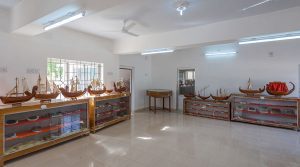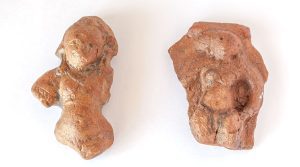
ASI revives underwater archaeology wing, TN can now unearth Poompuhar

The Union Ministry of Culture’s reply to the recommendation made by the Parliamentary Standing Committee on reviving underwater archaeology, is expected to make archaeologists across the country happy. Considering that the underwater archaeology wing of the Archaeological Survey of India (ASI) has been defunct for a decade, the revival of the wing, will hopefully add more insights to the underwater excavations that have been abandoned in the past.
In its 305th report on the Parliamentary Standing Committee on transport, tourism and culture, submitted to the Rajya Sabha on February 2 and laid before the Lok Sabha on the same day, the 31-member committee headed by TG Venkatesh, recommended to the ministry that underwater archaeological exploration has to be revived in the states of Maharashtra, Gujarat, Tamil Nadu (TN) and Odisha.
Pointing out that the ASI is reviving its underwater wing, the ministry said that an additional director general level officer, who has been posted recently is an underwater archaeology expert.
TN’s tryst with underwater archaeology
Interestingly, TN has a rich history of carrying out underwater archaeology. In 1981, the Goa-based National Institute of Oceanography (NIO), along with the TN’s archaeology department, had conducted an offshore exploration in Poompuhar, once an ancient TN port and now a town in Mayiladuthurai district. In ancient days, the 2,000 year-old town was known as Kaveripoompattinam or Kaveripattanam. During that exploration they had found some mysterious objects near the shore at a depth of 7 to 8 meters.
“Objects of similar nature were noticed in deeper waters but could not be identified as no diving was undertaken,” wrote Dr Sila Tripathi, a researcher at marine archaeology centre, NIO, in a paper published in 2004.
Also read: Obit: R. Nagaswamy, the doyen of archaeology, passes away in Chennai

“The results of previous land excavations by Archaeological Survey of India and offshore explorations of Poompuhar in 1981 attracted the TN department of archaeology, which came forward to carry out marine archaeological researches in Poompuhar waters in collaboration with the marine archaeology centre, NIO,” he added.
The exploration was made by deploying sophisticated machines such as side scan sonar, echo sounder and megnetometre. These sophisticated machines showed some tangible results on the graphs, said Natana Kasinathan, the then director of state archaeology department in his book Under sea exploration off the shore of Poompuhar published in 1991.
“On the advice of the NIO, state department of archaeology submitted a proposal to the government for carrying out the intensive exploration. Government was pleased to grant an initial sanction of about ₹10 lakh for the year 1990-1991,” he wrote.
Accordingly, the exploration was started on February 25, 1991. Between 1993 and 1995, the second and third phase of the exploration were carried out. During the explorations, some brick structures, terracotta ring wells, some wares and a shipwreck were found. Also a site, which was traditionally known as Karaiyappar was also identified.

“This site is about 4-5 km away from the seashore. If this structure is proved to be one of the structures of the ancient city of Poompuhar, then the city could have been extended up to this part. So there could be the possibility of having about half of the city submerged under the sea. The reference to the submersion of Poompuhar in literature has clear bearings and is proved beyond doubt by the material evidence. Further survey would reveal more facts about the glorious city of Poompuhar,” added Kasinathan.
Also watch: 3,200-year-old civilization confirmed in Tamil Nadu, Govt to excavate in other countries
The city was said to have been submerged under the sea off the Nagapattinam coast in TN. Reams of ancient Tamil literature and early geographers and historians like Ptolemy and Pliny have described the Chola town of Kaveripoompattinam as a vital maritime port that had trade links with the Roman empire and China before being washed away by tidal waves, now recogised as a tsunami.
‘More exploration needed in Puhar’
It is disheartening to note that even as the exploration in Poompuhar has not been carried out fully, the TN government has recently decided to go ahead with the exploration of another ancient port Korkai in Thoothukudi district from this year, said V Jeevakumar, an advocate and a Tiruchy-based archaeology enthusiast.
“In the olden days, the port Puhar was known by several names such as Kaveripattinam, Kakhandi, Cholapattinam, Champapathi and Kaberis Emporium. It was a busy port then and traded articles, food products and spices. The port’s urban planning was divided as Maruvurpakkam (where trading happened), Pattinappakkam (where temples and palaces were located) and Nalangadi (where natural groves thrived). Because of these reasons, the renowned Tamil scholar and historian TV Sadasiva Pandarathar has claimed that the beauty of Poopuhar was greater than the beauty of London,” he said.
It’s a pity the state government is overlooking these facts and shows no interest in carrying more exploration here, Jeevakumar added.
Talking to The Federal, Dr T Satyamurthy, former superintendent archeologist, ASI, Chennai circle said instead of going for underwater exploration in a new site, the government can concentrate on the existing site where archaeological evidences have already emerged.
“The exploration carried in Poompuhar was not even a search. It was just a scan. In off shore itself we have got more evidences. So let the government complete the searching in Puhar and then it can go to Korkai. As far as Korkai is concerned, there haven’t been any underwater archaeological evidences so far. Rather than going for more and more sites, let us go in for a deeper exploration of the existing sites. Instead of approaching this issue emotionally, we need to look at it from a scientific view,” he said.
Lamenting about the lack of underwater archaeological experts in the state, Satyamurthy added that the state can take the help of institutes like the Chennai based-National Institute of Ocean Technology, Geological Survey of India, etc.


